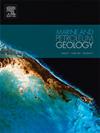Origin of the Cenozoic faults in the “B” structure of the central inversion belt in the northern part of the Xihu Sag, East China Sea Basin
IF 3.7
2区 地球科学
Q1 GEOSCIENCES, MULTIDISCIPLINARY
引用次数: 0
Abstract
The periodic activation of faults in the inversion belt facilitates hydrocarbon migration and accumulation while also potentially destabilizing pre-existing reservoirs, affecting long-term hydrocarbon stability. Based on 3D seismic data, and employing maximum likelihood attributes and time-slice-assisted analysis methods, this study systematically analyzes the fault geometry and relative motion characteristics, following the principle of corresponding points along cross-sections. The analysis of the fault's three-dimensional spatial evolution shows that the faults in the study area exhibit deep “rootless flower” and middle-to shallow-layer “flower-like” structural patterns. The deep-seated faults trend NE-NEE, with strike-slip movement changing from right-lateral to left-lateral. Middle-to shallow-layer faults are predominantly near E-W normal faults, with left-lateral strike-slip movements, forming Riedel R′ shear faults due to intense late compressional and rotational actions. The shallow faults show the strongest strike-slip activity, with the maximum slip displacement in the core reaching 820 m. These faults have undergone four main deformation stages: early Eocene extensional faulting, late Eocene positive inversion and strike-slip, Oligocene inherited strike-slip, and intense late Miocene strike-slip inversion. The phase-specific fault activity is primarily influenced by a combination of far-field tectonic processes, including the subduction retreat and rotation of the Pacific Plate, back-arc extension, remote effects from the India-Eurasia plate collision, and the migration and rotation of the Philippine Plate. Through an in-depth analysis of the fault evolution process, a more refined predictive model for the formation and evolution of hydrocarbon reservoirs has been established, providing crucial tectonic context and theoretical support for oil and gas exploration and development.
东海盆地西湖凹陷北部中央反转带“B”构造新生代断裂成因
反转带断层的周期性活动有利于油气的运移和聚集,同时也可能破坏原有储层的稳定,影响油气的长期稳定性。本文以三维地震资料为基础,采用极大似然属性和时间片辅助分析方法,遵循断层剖面对应点原则,系统分析断层几何形态和相对运动特征。三维空间演化分析表明,研究区断裂呈现深部“无根花”和中浅层“花状”构造格局。深部断裂走向NE-NEE,走滑运动由右旋向左旋转变。中浅层断层以东西向正断层附近为主,左侧走滑运动强烈,后期挤压和旋转作用强烈,形成里德尔R’型剪切断层。浅层断裂走滑活动最强,岩心最大滑动位移达820 m。这些断裂经历了四个主要变形阶段:早始新世伸展断裂、晚始新世正反转和走滑、渐新世继承走滑和晚中新世强烈走滑反转。断相活动主要受远场构造作用的综合影响,包括太平洋板块的俯冲后退和旋转、弧后伸展、印度-欧亚板块碰撞的远场影响以及菲律宾板块的迁移和旋转。通过对断裂演化过程的深入分析,建立了更为精细的油气藏形成演化预测模型,为油气勘探开发提供了重要的构造背景和理论支撑。
本文章由计算机程序翻译,如有差异,请以英文原文为准。
求助全文
约1分钟内获得全文
求助全文
来源期刊

Marine and Petroleum Geology
地学-地球科学综合
CiteScore
8.80
自引率
14.30%
发文量
475
审稿时长
63 days
期刊介绍:
Marine and Petroleum Geology is the pre-eminent international forum for the exchange of multidisciplinary concepts, interpretations and techniques for all concerned with marine and petroleum geology in industry, government and academia. Rapid bimonthly publication allows early communications of papers or short communications to the geoscience community.
Marine and Petroleum Geology is essential reading for geologists, geophysicists and explorationists in industry, government and academia working in the following areas: marine geology; basin analysis and evaluation; organic geochemistry; reserve/resource estimation; seismic stratigraphy; thermal models of basic evolution; sedimentary geology; continental margins; geophysical interpretation; structural geology/tectonics; formation evaluation techniques; well logging.
 求助内容:
求助内容: 应助结果提醒方式:
应助结果提醒方式:


